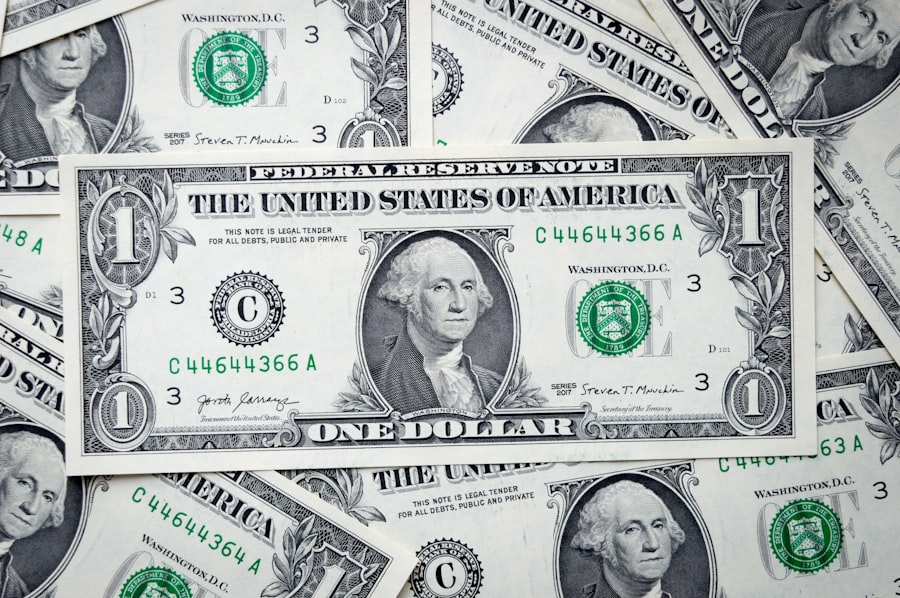As you navigate the complex landscape of global trade, one thing becomes abundantly clear: the U.S. dollar reigns supreme. Its dominance is not merely a product of chance; it is the result of decades of economic policies, historical events, and strategic decisions that have positioned the dollar as the world’s primary currency for international transactions.
This article delves into the multifaceted role of the dollar in global trade, exploring its historical context, its impact on exchange rates, and the challenges it faces in an ever-evolving economic environment. Understanding the dollar’s significance in global trade is crucial for anyone engaged in international business or finance. The dollar serves as a benchmark for pricing goods and services, influencing everything from oil prices to the cost of consumer electronics.
As you consider your own position within this global framework, it becomes essential to grasp how the dollar’s dominance shapes not only trade dynamics but also economic policies and relationships between nations.
Key Takeaways
- The US dollar’s dominance in global trade has far-reaching implications for international commerce and finance.
- The dollar’s rise to prominence can be traced back to historical events such as World War II and the Bretton Woods Agreement.
- As a reserve currency, the dollar’s impact on global trade is significant, influencing exchange rates and trade balances worldwide.
- Dollar-denominated commodities, such as oil, have a major impact on global markets and trade dynamics.
- The dollar plays a crucial role in international financial transactions, shaping the global financial system and impacting emerging markets and developing economies.
Historical Context: The Dollar’s Rise to Prominence
To appreciate the dollar’s current status, you must first examine its historical trajectory. The dollar’s ascent began in the aftermath of World War II when the Bretton Woods Agreement established it as the world’s primary reserve currency. This agreement was a pivotal moment, as it linked currencies to the dollar, which was itself convertible to gold at a fixed rate.
This system provided stability and predictability in international trade, allowing countries to engage in commerce with confidence. As you reflect on this historical context, consider how the U.S. economy emerged from the war as a dominant force.
With its industrial base intact and a wealth of resources, the United States was well-positioned to lead the global economy. The establishment of institutions like the International Monetary Fund (IMF) and the World Bank further solidified the dollar’s role in international finance, creating a framework that encouraged trade and investment across borders. This historical backdrop is essential for understanding why the dollar has maintained its prominence for so long.
The Dollar as a Reserve Currency: Its Impact on Global Trade

The dollar’s status as a reserve currency has profound implications for global trade. When countries hold dollars as part of their foreign exchange reserves, they are essentially betting on the stability and reliability of the U.S. economy. This trust allows for smoother transactions and reduces exchange rate risks, making it easier for nations to engage in trade with one another. As you consider your own business dealings, think about how this reliance on the dollar can simplify transactions and foster international partnerships. Moreover, the dollar’s reserve status creates a self-reinforcing cycle. As more countries adopt the dollar for trade, its value remains strong, which in turn encourages even more countries to use it. This phenomenon can be seen in various sectors, from energy markets to technology exports. The dollar’s dominance facilitates liquidity and efficiency in global trade, allowing businesses like yours to operate more effectively across borders.
The Dollar’s Influence on Exchange Rates and Trade Balances
| Country | Exchange Rate | Trade Balance |
|---|---|---|
| United States | 1 | Positive |
| China | 6.45 | Negative |
| European Union | 0.85 | Positive |
The influence of the dollar extends beyond mere transactions; it also plays a critical role in determining exchange rates and trade balances. When you engage in international trade, fluctuations in exchange rates can significantly impact your bottom line. A strong dollar can make U.S.
exports more expensive for foreign buyers, potentially leading to a trade deficit. Conversely, a weaker dollar can boost exports by making them more affordable abroad. As you analyze your own trade strategies, it’s essential to consider how changes in the dollar’s value can affect your competitiveness in global markets.
For instance, if you’re exporting goods to Europe and the dollar strengthens against the euro, your products may become less attractive to European consumers. Understanding these dynamics can help you make informed decisions about pricing, sourcing, and market entry strategies.
Dollar-Denominated Commodities: The Impact on Global Markets
One of the most significant aspects of the dollar’s dominance is its role in pricing commodities. Most global commodities—such as oil, gold, and agricultural products—are priced in dollars. This practice creates a direct link between commodity markets and the health of the U.S.
economy. As you consider your investments or business operations, it’s crucial to recognize how fluctuations in commodity prices can impact your financial outcomes. The reliance on dollar-denominated commodities also has broader implications for global markets.
When commodity prices rise due to increased demand or geopolitical tensions, countries that rely heavily on imports may face inflationary pressures. Conversely, nations that are major exporters of commodities can benefit from increased revenues. As you navigate these complexities, understanding how commodity pricing interacts with currency fluctuations can provide valuable insights into market trends and investment opportunities.
The Role of the Dollar in International Financial Transactions

In addition to its influence on trade and commodities, the dollar plays a central role in international financial transactions.
This practice simplifies processes and reduces risks associated with currency conversion.
For businesses like yours that operate internationally, this ease of use can be a significant advantage. Furthermore, the dollar’s dominance in financial markets means that many countries are compelled to maintain substantial dollar reserves to facilitate trade and investment. This demand for dollars creates liquidity in financial markets, allowing for easier access to capital for businesses around the world.
As you consider your own financial strategies, recognizing the importance of dollar liquidity can help you make informed decisions about funding and investment opportunities.
The Dollar’s Role in Emerging Markets and Developing Economies
The impact of the dollar is particularly pronounced in emerging markets and developing economies. Many of these nations rely on foreign investment and trade to fuel their growth, making them vulnerable to fluctuations in the dollar’s value. When the dollar strengthens, it can lead to capital outflows from these economies as investors seek safer assets denominated in dollars.
This dynamic can create challenges for businesses operating in these regions. As you explore opportunities in emerging markets, it’s essential to understand how local currencies interact with the dollar. Currency depreciation can make imports more expensive and exacerbate inflationary pressures, affecting consumer purchasing power and overall economic stability.
By staying informed about these trends, you can better position your business to navigate potential challenges while capitalizing on growth opportunities.
Challenges to the Dollar’s Dominance in Global Trade
Despite its long-standing dominance, the dollar faces several challenges that could threaten its position in global trade. One significant factor is the rise of alternative currencies and payment systems. Countries like China have been actively promoting their own currencies for international trade, seeking to reduce reliance on the dollar.
Additionally, geopolitical tensions and economic sanctions can create uncertainty around the dollar’s stability. Countries that find themselves at odds with U.S.
policies may seek alternatives to avoid potential repercussions from using dollars in their transactions. This shift could lead to increased volatility in global markets and create new opportunities for businesses willing to adapt to changing circumstances.
The Potential Impact of a Weakening Dollar on Global Trade
A weakening dollar could have far-reaching consequences for global trade dynamics. If the dollar were to lose value significantly, it could make U.S. exports more competitive while simultaneously increasing import costs for American consumers and businesses.
As you consider your own supply chain strategies, think about how a weaker dollar might influence your sourcing decisions and pricing strategies. Moreover, a declining dollar could lead to inflationary pressures domestically as import prices rise. This scenario could prompt shifts in consumer behavior and spending patterns, affecting demand for various goods and services.
Understanding these potential impacts can help you prepare for changes in market conditions and adjust your business strategies accordingly.
The Future of the Dollar in Global Trade: Opportunities and Threats
Looking ahead, the future of the dollar in global trade presents both opportunities and threats. On one hand, its established status as a reserve currency provides a level of stability that many countries still value highly. As you consider your long-term business strategies, this stability may offer reassurance when engaging in international transactions.
On the other hand, emerging technologies such as cryptocurrencies and digital currencies issued by central banks could disrupt traditional financial systems and challenge the dollar’s dominance. As these innovations gain traction, they may offer alternative means of conducting transactions that bypass traditional banking systems altogether. Staying informed about these developments will be crucial for adapting your business strategies to remain competitive in an evolving landscape.
The Continuing Influence of the Dollar in Global Trade
In conclusion, while challenges loom on the horizon for the U.S. dollar’s dominance in global trade, its influence remains profound and far-reaching. As you navigate this complex landscape, understanding the historical context, current dynamics, and potential future developments will be essential for making informed decisions that impact your business operations.
The dollar’s role as a reserve currency continues to facilitate international trade and investment while shaping economic policies worldwide. By staying attuned to shifts in currency dynamics and market trends, you can position yourself strategically within this ever-changing environment—ensuring that your business thrives amidst both opportunities and challenges presented by the ongoing evolution of global trade.
The dollar’s role in international trade has been a topic of significant discussion among economists and policymakers. As the world’s primary reserve currency, the dollar facilitates a vast majority of global transactions, influencing exchange rates and international economic policies. An interesting perspective on this topic can be found in a related article on the dynamics of currency influence in global markets. For more insights, you can read the article on Hey Did You Know This, which delves into the historical and current factors that sustain the dollar’s dominance in international trade.
WATCH IT HERE! 💰 The Secret History of the Dollar: How Oil Replaced Gold (The Petrodollar Mystery)
FAQs
What is the role of the dollar in international trade?
The dollar plays a dominant role in international trade as it is the most widely used currency for invoicing and settling trade transactions.
Why is the dollar the preferred currency for international trade?
The dollar’s status as the world’s primary reserve currency, its stability, and the size and liquidity of the US financial markets make it the preferred currency for international trade.
How does the dollar’s role in international trade impact global economies?
The dollar’s dominance in international trade can impact global economies by influencing exchange rates, trade imbalances, and the ability of countries to conduct trade and finance transactions.
What are the advantages and disadvantages of the dollar’s dominance in international trade?
Advantages of the dollar’s dominance include stability and liquidity, while disadvantages may include the potential for economic and financial vulnerabilities in countries heavily reliant on the dollar.
Are there any efforts to reduce the dollar’s dominance in international trade?
Some countries and international organizations have expressed interest in reducing the dollar’s dominance in international trade by promoting the use of alternative currencies or creating new international payment systems.
